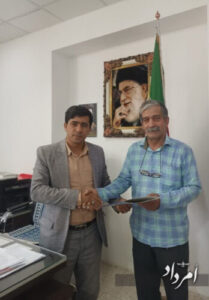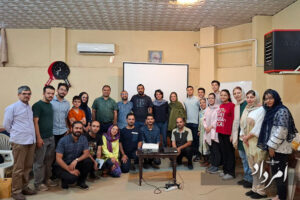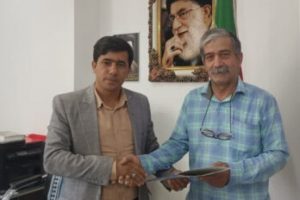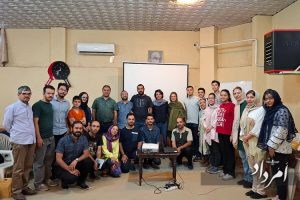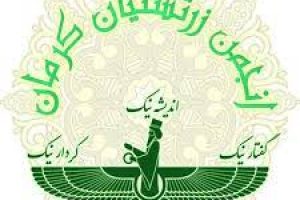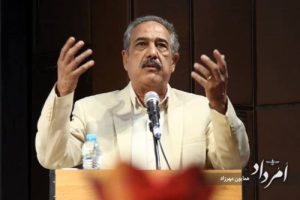El-Khader Nabi or El-Khader the prophet is a great figure in Abrahamic religions. Although he is not directly mentioned in religious books, various stories about this character exist among the followers of different religions. Interestingly, among the followers of non-Abrahamic religions, including some Zoroastrians, particularly in the villages of Yazd, the name of this character has been given to shrines such as Khajeh El-Khader of Allahabad, Khajeh El-Khader of Ali Abad, and Khajeh El-Khader of Mohammad Abad, which are especially respected by the Zoroastrians of Yazd and are managed by them. This short article discusses the joining of these shrines in the name of “Khajeh El-Khader.”
In various stories, particularly those narrated by some prominent followers of Abrahamic (Semitic) religions, El-Khader is mentioned as a prophet who takes care of the waters and seas, guides the lost at sea, and teaches hidden knowledge. In some of the narratives, it is said that after drinking the “water of life” he is bestowed eternal life and will continue living until the day of resurrection. Interestingly, there is another legendary, yet holy figure named El-Khader Elias, for whom the Zoroastrians have a shrine near Markar Square, called Pir Khajeh Elias.
Similar to many other regions of Iran, Yazd has places known as Pir El-Khader, Pir Khajeh El-Khader, Khajeh El-Khader, and Khezr Abad. According to the residents of nearby villages (especially women) those places that have a shrine-like appearance are associated with Hazrat El-Khader. Since the most important characteristic of El-Khader was his footsteps in finding the water of life, and the characteristic of always being alive, we can pay more attention to these two aspects (Mehrshahi, 1402).
At the beginning of the agricultural era, about 12,000 years ago (approximately) access to water was the most crucial and basic aspect of this way of living. For the people living in dry, semi-arid, and very low water regions of the world, access to drinkable water was the most valuable and primary source of life or sustainability (survival). As their way of life transitioned from nomadic hunting and gathering to agriculture, settlement, and the development of rural and urban areas emerged.
In areas with very little water, such as the Yazd region, where the significance of water has taken on the form of holiness and has been linked to a legendary character associated with the “water of life”, named Khaje Khedr, are there signs of those who were searching for water and finding it? This scene reflects the lives of these people. It can be assumed that such famous shrines as Khajeh El-Khader in Ali Abad and Allah Abad in Rostaq were, in fact, memorials to those who brought underground water (kariz) to these arid areas. This becomes particularly noteworthy when we consider that after each period of drought, devastating floods, or severe earthquakes, these skilled water engineers had to devise new plans and revive the vital network of underground water—essentially the lifeblood of the region.
On the other hand, according to Mirshokrayi (1383, p. 31), “According to the belief of the people in most parts of Iran, El-Khader is a prophet who has eternal life, a guide for those lost in the deserts, a provider of needs, and a helper to the needy. However, in some areas in the south, west, and north of the country, El-Khader has additional functions beyond these roles. Based on the mode of production or lifestyle, the economic and cultural relations, as well as the social and natural conditions of each region, he is recognized as the blessing agent of agriculture and agricultural products, the protector of livestock and their processes, the guardian of ships, and a benefactor to hunters and fishermen, along with being the owner and blesser of waters and springs. Similarly, in the central cultural regions of Iran, El-Khader fulfills needs, cures diseases, solves problems, and guides the lost in the deserts, with associations to vegetables and water” (Mirshokrayi, 1383).
We also observe that the aqueduct, which draws water from the well and channels it to the ponds and gardens of homes (in Kerman and Yazd), provides the water of life to the flowers and trees of the house—an action that aligns with one of the characteristics of Khajeh El-Khader by Parisi Bastani, an introduction to the book named Daneshvar, 1375 (1996).
Some researchers consider the origin of the Zoroastrian shrines of Yazd to be linked to Izad Soroush (deity), which, like the prophet El-Khader, is seen as forever living and immortal, serving as a mediator between the supernatural world and the earthly realm (Mary Boyce, 1967). On the other hand, some scholars have also dedicated sacred places such as Pir Sabz (Ardakan) and Pars Bano, along with other shrines located at springs, rivers, or water wells, to the goddess Anahita, who is the guardian of water, plants, life, and the reproduction of humans and animals. This goddess is considered related to fertility. Perhaps this same source, Anahita (Aradvi Sura Anahita) from the Avesta, as another possible counterpart of Khajeh El-Khader and Elias.
It is also important to note that Hazrat El-Khader, even though his name is not explicitly mentioned in the holy religious texts, is connected, through stories involving Moses and even Alexander, often depicted as having a familial relationship with Dhu al- Qarnayn. In these narratives, he pursues the water of life alongside these two figures (Moses in one account and Alexander in another), entering the quest for prophethood, faithfulness, and immortality (Daneshvar, 2015; Kauker, 2015). Otherwise, there is no independent mention of him, and his status as a prophet and immortal has largely been reached through interpretations and narratives by various scholars, philosophers, and religious commentators (N.K. Kauker, 2015).
In my opinion, regardless of the origin and foundation of the legend of Khajeh El-Khader among the people of Iran, one obvious fact remains: the ability to bring water from a great distance to lands that lack it, establishing agriculture and greenery that sustain the people’s lives, has been made possible through the efforts and knowledge of hydrological engineers, professors, and well diggers (Moqhani). The participation and cooperation of the community have also played a crucial role in this endeavor; without it, achieving success in the challenging task of transporting water from the mountains to the plains would not have been easy.
In general, in a land where the people did not have hope in their rulers, nor was the other conditions and natural environment favorable, seeking help from supernatural forces seemed natural to the common people. As a result, since the names of the living, victorious individuals—those who toiled diligently, such as well drillers, hydrological engineers, and metallurgical workers—were not remembered, they invoked an immaterial and non-earthly element called Soroush or Anahita to assist them. They attributed respect to the spring or river, the source of their life, and in their beliefs, they created a transcendental force to protect those vital resources.
To honor and collaborate with that transcendental force, they would offer a kerpan (sacrifice) or offering every year, sometimes sprinkling part of it on the ground, water, or river. In the post-Islamic era, these beliefs transformed from life-giving Soroush and Anahita into figures like Jamekhiz, Khajakhiz, and Pir-e Khedr. In this manner, Muslims, Zoroastrians, and Jews in Iran (and perhaps the entire region) engaged in various forms of partnership.
Dariush Mehrshahi (Sunday, Mehr 22, 1403)




